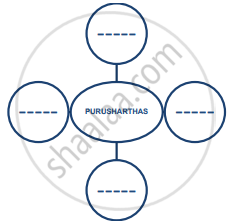Advertisements
Advertisements
प्रश्न
Differentiate between:
Traditional woman and Modern woman
उत्तर
| Points | Traditional woman | Modern woman | |
| (1) | Meaning | Initially, traditional women had access to education, but this declined over time. | Modern women have significantly improved access to education, supported by legal and social reforms. |
| (2) | Right to Marry | They enjoyed some early autonomy in marriage, which was reduced by practices such as child marriage. | Their marital rights are enhanced, including legal protection against child marriage and support for widow remarriage. |
| (3) | Social and Religious Rights | Traditional women were active in early Vedic social and religious spheres but were later restricted to household duties. | Modern women are active in public life, engage in various professions, and participate more inclusively in religious activities. |
| (4) | Legal Rights | Their legal rights were limited; they were dependent on male relatives and had no property rights. | They have enhanced legal rights, including property and inheritance rights, and are protected against discrimination. |
APPEARS IN
संबंधित प्रश्न
What was the nature of education during the Early Vedic period?
Mention any two characteristics of the Indian society in the Medieval period.
Monks in Buddhist monasteries were called ______.
Correct the underlined word and complete the statement.
Elementary education was imparted in Khanqahs during the medieval period.
Write short notes.
Education during the Early Vedic period.
Write differences.
Status of Women in the Early Vedic Period and Later Vedic Period
Explain the following concept with examples.
Varna system
Buddhism spread to several parts of India and beyond.
The sacred book of Jews is ______.
The purusharthas is a part of ______ teaching.
Digambara and Shvetambara are sects in ______.
Maktabs were centres of ______.
Identify the appropriate term from the given option in the box and rewrite it against the given statement.
DRA VIDIAN LANGUAGE FAMILY
VARDHAMAN MAHAVIR
PANDIT NEHRU
INDO-ARYAN LANGUAGE FAMILY
DANIEL LERNER
PATRIARCHY
- Considered to be ‘Kevalin’ (omniscient)
- Sociologist who coined the term ‘ modernisation’
- Kashmiri, Assamese, Bengali
- Panchsheel philosophy
- Male dominance in society
Status of women in India during Later Vedic Period.
Write differences.
Zoroastrianism and Islam
Explain the following concept with examples.
Ashramvyavastha
Explain the following concept with example.
Langar
Complete the concept map.

State whether the following statement are true or false with reason.
Buddhism spread to several parts of India and beyond.
Answer the following question in detail (in 150-200 words).
‘Religion has an impact on society.’ Discuss with suitable examples.
Correct the incorrect pair and rewrite it.
Correct the underlined words, complete and rewrite the statement:
Judaism is polytheistic religion.
Differentiate between Christianity and Islam.
Correct the incorrect pair and rewrite it.
Correct the underlined words and complete the sentence.
Sikhism was founded by Guru Govind Singh.
Identify the appropriate term from the given options and rewrite it against the given statement.
Founder of Sikhism.
Correct the underlined word and complete the statement.
Higher education was imparted in Khangahs during the medieval period.
The new religion Din-I-Ilahi was established by ______.
Identify the appropriate term from the given options and rewrite it against the given statement:
Doing one’s duties by following the path of righteousness, without the expectation of a reward.
Correct the underlined word, and complete and rewrite the statement:
Pangat is the Punjabi term for the community kitchen.
